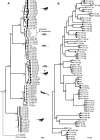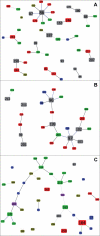Population genetics, taxonomy, phylogeny and evolution of Borrelia burgdorferi sensu lato
- PMID: 21843658
- PMCID: PMC3214628
- DOI: 10.1016/j.meegid.2011.07.022
Population genetics, taxonomy, phylogeny and evolution of Borrelia burgdorferi sensu lato
Abstract
In order to understand the population structure and dynamics of bacterial microorganisms, typing systems that accurately reflect the phylogenetic and evolutionary relationship of the agents are required. Over the past 15 years multilocus sequence typing schemes have replaced single locus approaches, giving novel insights into phylogenetic and evolutionary relationships of many bacterial species and facilitating taxonomy. Since 2004, several schemes using multiple loci have been developed to better understand the taxonomy, phylogeny and evolution of Lyme borreliosis spirochetes and in this paper we have reviewed and summarized the progress that has been made for this important group of vector-borne zoonotic bacteria.
Copyright © 2011 Elsevier B.V. All rights reserved.
Figures


 , B. garinii – ●, B. bavariensis -
, B. garinii – ●, B. bavariensis -  , B. valaisiana – ⦿, and B. lusitaniae – ▼. The MLST tree was rooted with sequences of the relapsing fever spirochetes B. duttonii, B. hermsii, and B. turicatae. The branch length of the outgroup is not according to scale as indicated by slashes. While in the MLST tree LB species cluster monophyletically, this is not the case using ospC sequences (original figure A from Population Biology of Lyme Borreliosis Spirochetes; Kurtenbach et al [2010], DOI: 10.1002/9780470600122.ch12; Copyright (2010, John Wiley & Sons); reprinted with permission of John Wiley & Sons, Inc.; original figure B Margos et al. [2009], doi 10.1128/AEM.00116-09, reproduced and modified with permission from the American Society for Microbiology)
, B. valaisiana – ⦿, and B. lusitaniae – ▼. The MLST tree was rooted with sequences of the relapsing fever spirochetes B. duttonii, B. hermsii, and B. turicatae. The branch length of the outgroup is not according to scale as indicated by slashes. While in the MLST tree LB species cluster monophyletically, this is not the case using ospC sequences (original figure A from Population Biology of Lyme Borreliosis Spirochetes; Kurtenbach et al [2010], DOI: 10.1002/9780470600122.ch12; Copyright (2010, John Wiley & Sons); reprinted with permission of John Wiley & Sons, Inc.; original figure B Margos et al. [2009], doi 10.1128/AEM.00116-09, reproduced and modified with permission from the American Society for Microbiology)






References
-
- Achtman M. Population structure of pathogenic bacteria revisited. Int J Med Microbiol. 2004;294:67–73. - PubMed
-
- Amore G, Tomassone L, Grego E, Ragagli C, Bertolotti L, Nebbia P, Rosati S, Mannelli A. Borrelia lusitaniae in immature Ixodes ricinus (Acari: Ixodidae) feeding on common wall lizards in Tuscany, central Italy. J Med Entomol. 2007;44:303–307. - PubMed
-
- Attie O, Bruno JF, Xu Y, Qiu D, Luft BJ, Qiu WG. Co-evolution of the outer surface protein C gene (ospC) and intraspecific lineages of Borrelia burgdorferi sensu stricto in the northeastern United States. Infect Genet Evol. 2007;7:1–12. - PubMed
Publication types
MeSH terms
Grants and funding
LinkOut - more resources
Full Text Sources
Miscellaneous

